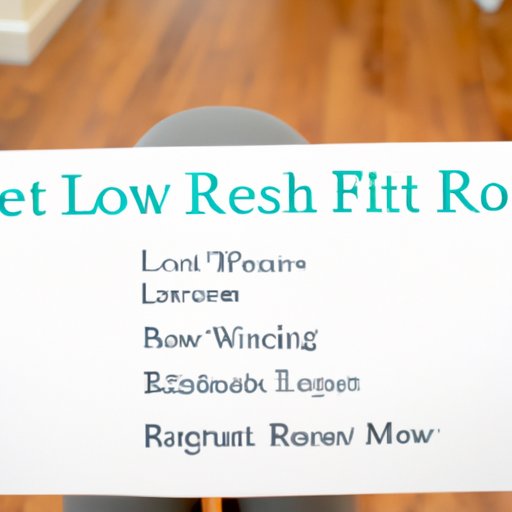Introduction
When it comes to losing weight, many people find themselves asking the same question: “How much weight can I lose in 3 months?” Before we can answer this question, it’s important to understand what weight loss is and what kind of goals are realistic.
Calculating Your Weight Loss Goals: How Much Weight Can You Lose in 3 Months?
Weight loss is the process of burning more calories than you consume. To achieve this, you need to create a calorie deficit — meaning you’re taking in fewer calories than your body needs to maintain its current weight. The size of the calorie deficit will determine how much weight you can lose in 3 months.
Estimating Your Calorie Deficit
The amount of calories you need to consume to maintain your current weight is based on your basal metabolic rate (BMR). Your BMR is the number of calories your body burns at rest. To calculate your BMR, use the Harris-Benedict equation:
For men: BMR = 66 + (13.7 x weight in kg) + (5 x height in cm) – (6.8 x age in years)
For women: BMR = 655 + (9.6 x weight in kg) + (1.8 x height in cm) – (4.7 x age in years)
Understanding Your Basal Metabolic Rate (BMR)
Once you’ve calculated your BMR, you can estimate your daily calorie needs by multiplying your BMR by an activity factor. If you lead a sedentary lifestyle (little or no exercise), use 1.2 as your activity factor. If you’re moderately active (light exercise 1-3 days per week), use 1.375. If you’re very active (moderate exercise 3-5 days per week), use 1.55. If you’re extra active (hard exercise 6-7 days per week), use 1.725.
Taking into Account Activity Level
To lose weight, you need to create a calorie deficit. To do this, you must figure out how many calories you need to consume each day to maintain your current weight, then reduce that number by 500-1000 calories per day. For example, if you need 2500 calories to maintain your weight, you should aim to consume 1500-2000 calories per day to achieve a healthy weight loss of 1-2 pounds per week.
The Science of Losing Weight: What’s the Maximum Amount of Weight You Can Lose in 3 Months?
Now that you have a better understanding of how to calculate your calorie needs and create a calorie deficit, let’s take a closer look at the science of weight loss. There are several factors that can affect how much weight you can lose in 3 months, including your diet, exercise routine, and overall health.
Factors that Affect Weight Loss
Your diet plays a major role in weight loss. Eating a balanced diet that includes plenty of fruits, vegetables, whole grains, lean proteins, and healthy fats will help you lose weight and keep it off. Additionally, regular physical activity is essential for successful weight loss. Exercise helps to burn calories and build muscle, both of which can help you reach your weight loss goals. Finally, your overall health can affect your ability to lose weight. People with chronic conditions such as diabetes or heart disease may not be able to lose as much weight as those who don’t have these conditions.
Reviewing Recommended Weight Loss Guidelines
According to the National Institutes of Health (NIH), a safe and healthy rate of weight loss is 1-2 pounds per week. This means that if you have a goal of losing 20 pounds in 3 months, you should aim to lose 5-10 pounds per month. While it is possible to lose more than this, it’s not recommended as rapid weight loss can be unhealthy and unsustainable.

Achieving Realistic Weight Loss Results: What to Expect from a 3 Month Weight Loss Program
Although it’s possible to lose 20 pounds in 3 months, it’s important to remember that everyone’s body is different and weight loss results can vary. To increase your chances of success, it’s important to set realistic goals and create a tailored plan that works for you.
Setting SMART Goals
SMART stands for Specific, Measurable, Attainable, Relevant, and Timely. When setting weight loss goals, make sure they meet all five criteria. For example, instead of setting a vague goal of “losing weight,” set a specific goal of “losing 10 pounds in 3 months.” Make sure your goal is measurable (e.g., 10 pounds) and attainable (e.g., losing 1-2 pounds per week). Additionally, your goal should be relevant to your lifestyle and timeline (e.g., 3 months).
Different Types of Eating Plans
In order to achieve your weight loss goals, it’s important to follow a healthy eating plan. There are several different types of eating plans that can help you reach your goals, such as low-carb diets, low-fat diets, and meal replacement plans. Talk to a nutritionist or dietitian to determine which type of eating plan is right for you.
Creating an Exercise Routine
In addition to following a healthy eating plan, it’s important to incorporate physical activity into your weight loss plan. Exercise helps to burn calories, boost metabolism, and build muscle. Aim to get at least 30 minutes of moderate-intensity physical activity most days of the week. Examples of moderate-intensity activities include walking, jogging, biking, swimming, and dancing.
Setting Yourself Up for Success: Strategies for Reaching Your Weight Loss Goals in 3 Months
Once you’ve created your weight loss plan, there are several strategies you can use to ensure your success. These include developing accountability, tracking your progress, and making adjustments as needed.
Developing Accountability
Having someone to hold you accountable can help you stay motivated and on track with your weight loss plan. Ask a friend or family member to join you on your weight loss journey or consider joining a weight loss support group.
Tracking Your Progress
Tracking your progress can help you stay focused and motivated. Keep a food diary and record your daily calorie intake. Additionally, weigh yourself once a week to monitor your weight loss.
Making Adjustments as Needed
It’s important to remember that weight loss isn’t always linear. If you’re not seeing the results you want, don’t give up! Take a step back and evaluate your diet and exercise routine. Consider talking to a nutritionist or personal trainer for advice on how to adjust your plan to maximize your results.

Overcoming Challenges: Tips for Staying on Track with Your 3 Month Weight Loss Plan
Losing weight can be challenging, and it’s normal to experience setbacks along the way. To stay on track with your 3 month weight loss plan, it’s important to identify obstacles and triggers, develop coping strategies, and seek support when needed.
Identifying Obstacles and Triggers
Take some time to think about any obstacles or triggers that might be keeping you from reaching your goals. Common obstacles include lack of time, lack of motivation, or unhealthy habits. Identifying these obstacles can help you develop strategies to overcome them.
Developing Coping Strategies
Once you’ve identified your obstacles and triggers, it’s time to come up with coping strategies. For example, if you lack motivation, try setting small, achievable goals or enlisting a friend or family member to hold you accountable. If unhealthy habits are keeping you from reaching your goals, try replacing them with healthier alternatives.
Seeking Support
Finally, don’t be afraid to ask for help. Reach out to a healthcare provider, nutritionist, personal trainer, or mental health professional for advice and guidance. Additionally, consider joining a weight loss support group for additional encouragement and motivation.
Conclusion
Losing weight can be a challenge, but with the right approach, it is possible to reach your 3 month weight loss goals. To maximize your results, create a tailored plan that includes a healthy eating plan, regular physical activity, and strategies for overcoming obstacles. With the right plan in place, you can reach your weight loss goals in no time.
(Note: Is this article not meeting your expectations? Do you have knowledge or insights to share? Unlock new opportunities and expand your reach by joining our authors team. Click Registration to join us and share your expertise with our readers.)
